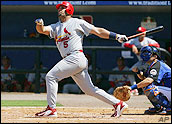
It’s opening day in many Major League Baseball stadiums today, and in addition to wondering who’s throwing out the first pitch, how much the beer will cost, and whether that rookie shortstop can hit the curveball, competitive and committed fans of this great sport are grappling with another burning question: How will my fantasy baseball team do this season?
Fantasy sports has become a multibillion dollar enterprise in the U.S. More than US$3 billion is spent annually by players in fantasy leagues, according to a survey released in March by the Fantasy Sports Trade Association. Those figures don’t include revenue generated by advertisers trying to attract those players.
Big Money Means Big Competition
“Rotisserie” baseball has come a long way since 1980, when magazine writer/editor Daniel Okrent, who is credited with creating the first “Rotisserie” league at the New York City restaurant La Rotisserie Francaise, used to meet with friends there to play. The game’s innovation was that “owners” in a Rotisserie league would draft teams from the list of active Major League Baseball players and would follow their statistics during the ongoing season to compile their team’s scores.
In the early days of “Rotisserie” baseball, now better known as fantasy baseball, all the statistics were compiled by hand. The commissioner of the league would painstakingly comb through the box scores and plug in the stats for each player who was on a team in the Rotisserie league. It was a thankless task that could sometimes take hours to complete daily. Thankfully, the Internet came along, and all that has changed.
Like all service-oriented industries, fantasy sports now finds itself in the midst of widespread competition among services that offer everything from keeping your league’s statistics to providing “expert” opinions on whom you should draft. These services charge anywhere from $60 to $250 to run a 12-team league. All the big online sports players, including, ESPN, Yahoo and CBS Sportsline.com, offer a service; thousands of smaller companies have their own versions.
While most of these sites offer similar features, the key considerations in choosing the best site to run your league are familiar ones in the world of CRM: service and support.
Is Anyone Out There?
Another main feature that most of the sites offer is a live online draft. With the cyber world being what it is today, it is possible for owners in several different locations to participate in the draft at the same time — this is so much better than the old days when you had to call an owner to tell him what the last 10 picks were as you waited for him to decide what his pick would be.
During my draft last week, we encountered several problems with the Web site we were using. As we were about to begin the draft, half of last year’s teams were somehow reinstated, and there were several players already placed on teams.
The commissioner made several attempts to contact the service by telephone and e-mail without any luck. After a 10 to 15 minute delay, he had to manually delete all the players from the teams they were placed on, and then suspend and restart the draft.
Everything then seemed to be fine as we made our way through the first round of picks, until we got to the second pick of the second round. At that point, the owner who was supposed to pick next noticed that the online draft was showing that it was a different owner’s pick. The site had randomly selected which team’s pick was coming up rather than maintaining the “snake” format that is used in almost all drafts, and the one that the commissioner had input as the format for our draft.
Again, we were unable to contact anyone at the company. After another lengthy delay, we had to suspend and reset the draft, and start all over. Eventually, we were able to complete the draft — but not before we had all decided this was the last year we would be using this site to run our league.
Service Not an Issue – Yet
When businesses do surveys to find out why their customers chose them, and why they would continue or discontinue patronizing them, invariably the top answer is service. Price usually comes in somewhere around No. 3 or 4 out of the top 10. Knowing this, I’m always amazed when I run into service issues like the one my league experienced last week.
Many companies in industries such as technology need to work hard to gain and retain customers. People already have cell phones, iPods and computers, but because the fantasy sports phenomenon is still somewhat new, we are still in an early market situation. It is a sellers’ market to be sure, according to Denis Pombriant, founder and managing principal of the Beagle Research Group, a CRM market research firm and consultancy.
“At the moment, sellers don’t have to give great service, because customers are plentiful,” Pombriant noted. “The graph of new participants in fantasy sports is going up rather steeply. Until the graph levels off, don’t expect better service. These guys are building two things right now — market share and infrastructure — and the two are mutually defeating in the short term in regard to quality service,” he concluded.
If one of these online services could decide to put service and support ahead of profit, they might actually make more money by gaining and keeping more customers. Unfortunately, that doesn’t seem to be the trend. As our esteemed fantasy football commissioner put it, “The gouging of the American fantasy sports enthusiast is in full swing.”
Now if Ben Sheets can get off the disabled list and Richie Sexson can belt 40 home runs this season, maybe I can make enough money to pay for next season’s football league.














































